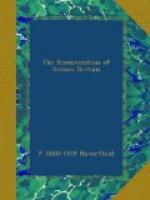The origin of these northern house-types has been much disputed. English writers tend to regard them as embodying a Celtic form of house; German archaeologists try to derive them from the ‘Peristyle houses’ built round colonnaded courts in Roman Africa and in the east. It may be admitted that the influence of this class of house has not infrequently affected builders in Roman Britain. But the differences between the British ‘Courtyard house’ and that of the south are very considerable. In particular, the amount of ground covered by the courts differs entirely in the two kinds of houses, while for the British houses of the plainer ‘corridor’ type the Mediterranean lands offer no analogies. We cannot find in them either atrium or impluvium, tablinum or peristyle, such as we find in Italy, and we must suppose them to be Roman modifications of really Celtic originals. This, however, no more implies that their occupants were mere Celts than the use of a bungalow in India proves the inhabitant to be a native Indian.[1]
[Footnote 1: Vict. Hist. Somerset, i. 213-14. A few Romano-British houses at Silchester (in insula xiv. (1), see Archaeologia, lv. 221) and at Caerwent (house No. 3, see Arch. lvii, plate 40) do bear some resemblance to the Mediterranean type, as I have observed in Archaeol. Anzeiger, 1902, p. 105. But they stand alone. Similarly, parallels may be drawn between Pompeian wall-paintings of houses and certain ‘villa’ remains in western Germany, as at Nennig; see Rostowzew, Archaeol. Jahrbuch, 1904, p. 103. But these again seem to me the exception.]
The point is made clearer by the character of the internal fittings, for these are wholly borrowed from Italian sources. If we cannot find in the Romano-British house either atrium or impluvium, tablinum or peristyle, such as we find regularly in Italy, we have none the less the painted wall-plaster (Fig. 11) and mosaic floors, the hypocausts and bath-rooms of Italy. The wall-paintings and mosaics may be poorer in Britain, the hypocausts more numerous; the things themselves are those of the south. No mosaic, I believe, has ever come to light in the whole of Roman Britain which represents any local subject or contains any unclassical feature. The usual ornamentation consists either of mythological scenes, such as Orpheus charming the animals, or Apollo chasing Daphne, or Actaeon rent by his hounds, or of geometrical devices like the so-called Asiatic shields which are purely of classical origin.[1] Perhaps we may detect in Britain a special fondness for the cable or guilloche pattern, and we may conjecture that from Romano-British mosaics it passed in a modified form into Later Celtic art. But the ornament itself, whether in single border or in many-stranded panels of plaitwork, occurs not rarely in Italy as well as in thoroughly Romanized lands like southern Spain and southern Gaul and Africa, and also in Greece and Asia Minor. It is a classical, not a British pattern.




